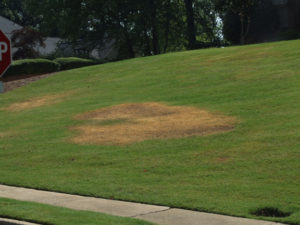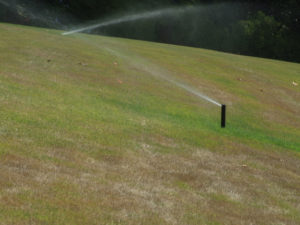As temperatures increase and the rains diminish, it is often difficult to determine whether your turf is in severe drought stress or in the clutches of disease.
First ask yourself, have you been irrigating your turf regularly and adequately? Regularly, meaning each and every week, and adequately, meaning at least 1″ of water, delivered in one application each week. If the answer is no, then your first job is to correct this situation and see if the turf responds. If you have been watering, how is your compaction level? Have you been aerating to reduce compaction? Did you choose to save money by not aerating? This is a fine example of false economy as you watch your lawn deteriorate during the summer. In compacted soil the water and nutrients will not sufficiently penetrate the soil surface, much less move into the soil stratum. If you have been watering and your compaction level is satisfactory, then it’s time to take a closer look at your turf.
Take grass samples from the edge of the brown turf areas and examine the actual blades of grass. If you see small brown spots on the leaf blades then most likely you are looking at Brown Patch lesions and a fungicide treatment is in order Fescue Disease Example . If on the other hand you find no spots and the leaf blade edges are curled inward, then you need to return to the lack of moisture theory. There could be a subsurface problem such as a rock or a hardpan which is not overtly apparent. Excessive amounts of sand may be the culprit also. Conditions like this may be isolated in small areas of your lawn and not only reduce grass root penetration but also restrict water penetration. When you water, watch to see if you are getting excessive runoff in these areas we call “hotspots”. A high amount of runoff may indicate such a problem. The remedy in these cases is to identify the problem and eliminate it.
 In many instances, especially during hot and dry conditions, areas in the turf that appear to be disease activity are simply dry areas we call “hot spots”. Checking the soil in these areas will quickly show that the soil is excessively dry.The reason these spots develop especially with irrigation is a simple problem called sprinkler over throw. Each head must be checked to insure that not only is it working but that it is properly distributing the water. Note the arc of the stream “overthrowing” the dry, brown area. The remedy is fairly simple. Adjust the head so that the stream is “feathered” and that adequate water is actually falling beneath the arc of the water stream.
In many instances, especially during hot and dry conditions, areas in the turf that appear to be disease activity are simply dry areas we call “hot spots”. Checking the soil in these areas will quickly show that the soil is excessively dry.The reason these spots develop especially with irrigation is a simple problem called sprinkler over throw. Each head must be checked to insure that not only is it working but that it is properly distributing the water. Note the arc of the stream “overthrowing” the dry, brown area. The remedy is fairly simple. Adjust the head so that the stream is “feathered” and that adequate water is actually falling beneath the arc of the water stream. 
Initially, if a hot spot occurs, spot water the affected area for 1 – 2 hours to rehydrate the area. Your watering schedule should be 1X per week to yield ~1″ of water during most of the year and 2X per week to yield 1″ of water per application when temperatures are above 90 degrees.
For more on high temperature dieback click here.
« Back to Glossary Index